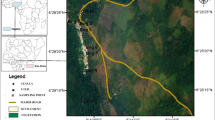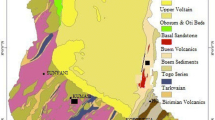Abstract
Geophagy of multani mitti (MM) clay is very common in central Pakistan especially amongst women. It was therefore mandatory to establish baseline levels of toxic elements in this clay for its safe dietary consumption by consumers of different genders, age groups and physical states. Instrumental neutron activation analysis and atomic absorption spectrometry techniques were used to determine the nutritional safety of MM clay for oral intake. All quantified toxic elements were detected at trace levels with composition in the descending order; Pb > Br > As > Sb > Hg > Cd. Comparison of these elements in MM clay with other clays shows that As, Cd, and Pb, are lowest in MM clay while its Br and Hg contents are high. Highest weekly dietary intakes of As, Br, Cd, Hg, and Sb were found to be 18, 0.05, 1.6, 9.2 and 1.1 % of the respective recommended provisional tolerable weekly intakes. The findings of this study show that As, Br, Cd, Hg and Sb in MM clay are well below the tolerance levels. However its Pb concentration is very high and may pose health concerns. The data presented in this study can be used as national base level guideline for geophagy of MM clay by men, women (normal, pregnant and lactating) and children.





Similar content being viewed by others
References
Bergaya F, Theng BKG, Lagaly G (2006) Development in clay science. In: Handbook of clay science, vol 1, Chapt. 11.5. Elsevier publications, Amsterdam, p 717
Finkelman RB (2006) Int J Environ Res Public Health 3:338
Mascolo N, Summa V, Tateo F (1999) Appl Clay Sci 15:491
Quig D (1998) Altern Med Rev 3:262
Flora SJS, Mehta MM (2008) Ind J Med Res 128:221
Njinga RL, Alf B, Sunday O, Muhammad TA (2011) Adv Appl Sci Res 2:370
Wasim M (2010) J Radioanal Nucl Chem 285:337
Sastre J, Sahuquillo A, Vidal M, Rauret G (2002) Anal Chim Acta 462:59
Waheed S, Zaidi JH, Ahmad S (2003) J Radioanal Nucl Chem 258:73
Waheed S, Ahmad S, Zaidi JH, Rahman A, Qureshi IH, Saleem M (2001) Radiochim Acta 89:425
Kane JS (2001) Geostand Newslett 25:7
Pszonicki L, Hanna AN, Suschny O (1984) Report on the intercomaprison run soil-7. Report No. 49: IAEA/Rl/112, IAEA, Vienna
Mee LD, Oregioni B (1991) IAEA/MEL, World-wide Intercomparison of trace element measurements in marine sediments SD-M-2/TM. Report No. 49: IAEA/AL/053, IAEA, Vienna
Silva PSC, Oliveira SMB, Farias L, Fávaro DIT, Mazzilli BP (2011) Appl Clay Sci 52:145
Kogel JE, Lewis SA (2001) Clays Clay Min 49:387
International Atomic Energy Agency (2003) Nuclear analytical techniques in archaeological investigations. International Atomic Energy Agency, Vienna Technical Reports Series, No. 416: ISSN 0074–1914
Vallius H (2007) Geol Surv Finl 45:63
Food Standard Agency (2009) Food survey information sheet 01/09
Al-Rmalli SW, Jenkins RO, Watts MJ, Haris PI (2010) Environ Health 9:79
Jomova K, Jenisova Z, Feszterova M, Baros S, Liska J, Hudecova D, Rhodes CJ, Valko M (2011) J Appl Toxicol 2011(31):95–107
Kapaj S, Peterson A, Liber A, hattacharya P (2006) J Environ Sci Health A 41:2399
Zhang HH, Yuan HX, Hu YG, Wu ZF, Zhu LA, Zhu L, Li FB, LI DQ (2006) China Environ Pollut 144:492–499
Waheed S, Rahman S, Gill KP (2009) J Radioanal Nucl Chem 279:725
Pavelka S (2004) Physiol Res 53:S81
Subramanian KS, Iyengar GV, Okamoto K (eds) (1991) Biological trace element research: multidisciplinary perspectives, ACS Symposium Series. American Chemical Society, Washington DC
Godt J, Scheidig F, Siestrup CG, Brandenburg VPE, Reich A, Groneber DA (2006) J Occup Med Toxicol 1:22
Khansakorn N, Wongwit W, Tharnpoophasiam P, Hengprasith B, Suwannathon L, Chanprasertyothin S, Sura T, Kaojarern S, Sritara P (2012) J Toxicol. doi:10.1155/2012/356126
Center for Disease Control and Prevention (2001) MMWR 50(08): 140–143
Lopes CB, Coimbra J, Otero M, Pereira E, Duarte AC, Lin Z, Rocha J (2008) Quím Nova 31:321
Samlafo BV, Aidoo A, Sarsah JBK, Quarshie LA, Serfor-Armah YE (2011) J Environ Earth Sci 3:541
Nayak D, Lahiri S (2002) J Radioanal Nucl Chem 254:619–623
World Health Organization (2011) Brief guide to analytical methods for measuring lead in paint, the inter-organization programme for the sound management of chemicals (IOMC) World Health Organization NLM classification: QV 292
Ambrose MT, Al-Lozi M, Scott MG (2000) Clin Chem 46:1171
Ljung K, Palm B, Grandér M, Vahter M (2011) Food Chem 127:943
WHO Technical Report Series 960 (2011) Evaluation of certain food additives and contaminants, seventy-third report of the Joint FAO/WHO expert committee on food additives, food and agriculture organization of the United Nations
Cooper RG, Harrison AP (2009) Ind J Occup Environ Med 13:3
World Health Organization (2003) Antimony in drinking-water, background document for development of WHO guidelines for drinking-water quality (GDWQ). World Health Organization WHO/SDE/WSH/03.04/74
Toghill KE, Lu M, Compton RG (2011) Int J Electrochem Sci 6:3057
Office of Pollution Prevention (2002) Fact sheet, persistent, bioaccumulative and toxic chemical, antimony and antimony compounds, vol 102. Office of Pollution Prevention, Columbus
Corte FD, Simonits A, Wispelaere AD, Hoste J, Moens L, Demeter AA (1986) Compilation of K0, Au-factors and related nuclear data for 112 radionuclides of interest in NAA, INW/KFKI interim report
Author information
Authors and Affiliations
Corresponding author
Rights and permissions
About this article
Cite this article
Waheed, S., Faiz, Y., Rahman, S. et al. Toxic element composition of multani mitti clay for nutritional safety. J Radioanal Nucl Chem 295, 143–150 (2013). https://doi.org/10.1007/s10967-012-1876-x
Received:
Published:
Issue Date:
DOI: https://doi.org/10.1007/s10967-012-1876-x




